When William Hollingsworth Jr. arrived in Chicago in 1930 his head was filled with a pragmatic, far-from-airy dream. As his chums back in his hometown of Jackson, Mississippi, trained for jobs as clerks, lawyers, businessmen, or engineers, he fancied success as a commercial artist.
He was a slump-shouldered, boyish fellow of twenty adept at cartooning. He had spent two years at the University of Mississippi as a general student, but he reasoned that his talent would shine brighter and his chances of finding a job as an artist would be bettered if he enrolled in an art school. He was accepted at the School of the Art Institute of Chicago. Charged with a beginner’s zeal, he pitched his home-grown talents into serious study and the result was a promising transformation. His classes in painting and his growing passion for the masterworks hanging in the galleries of the Institute awakened him to fine art. It became his calling. Even if commercial art (magazine illustration, poster design, book covers, advertising agency work) became the source of his livelihood after graduation, he resolved to be a painter too.
A cherished Mississippi painter
Today, Hollingsworth is a fixture in the pantheon of southern art. Since his death he has been rediscovered repeatedly as new appreciators are enchanted by his paintings. Though he died before satisfying his own high aim of being a recognized original, the multitude of watercolors and oil paintings that he produced in the short span of a decade is an astonishing achievement. In select art collections, mostly in the South, his works are cherished as unique and masterly.
Although blessed with a talent to produce art that burns with dazzling imaginative vision, Hollingsworth himself was modest and unassuming. He looked like just any other ordinary guy. He was a little under six feet tall and dark-haired, but sallow and very thin. A bit shy, he had a scholarly appearance because of his gold-rimmed spectacles. Though remembered as “withdrawn,” he was well liked among his set, and during school days in Jackson he was the known cartoonist in the crowd. His father once had financed a summer trip to Chicago so that young Hollingsworth could meet Cary Orr, the famous cartoonist of the Chicago Tribune.
Not only did the Institute wakened Hollingsworth’s creative powers, but it was the place he met Jane Oakley. She too was a student, although enrolled in the school of design. She had more training and more skill, but she watched in astonishment as Hollingsworth quickly surpassed her.
“At first I was better than he was,” Jane recalled, “but it wasn’t long before Hollie was the star student. All of us admired his abilities and his work.”
Jane’s hometown was Moline, Illinois, and her outlook was northern, Hollie’s decidedly southern. However, drawn together in their discussions of art, they grew close, fell in love, and married. A year later their son Billy was born.
Along with his creative gift, Hollingsworth had a strain of melancholy that cast him into dark moods. Jane understood him and tried to soothe and encourage him. This inescapable sadness tinges all his work. It peaked in the art of his prime.
An artist is born
At 1:00 a.m. on February 17, 1910, William Robert Hollingsworth Jr. was born at the family home, 754 North President Street in Jackson. When he was less than a year old, his mother (née Willie Belle Van Zile) died suddenly, and he was reared by his father and his elder sister Isabel, who was thirteen years older than her brother. William R. Hollingsworth Sr., with Fred A. Tyson, his son-in-law, headed a firm called Hollingsworth & Tyson Real Estate and Rental Agents. His offices were downtown in the Merchants Bank and Trust Building. The new residential development of Belhaven was among the senior Hollingsworth’s projects.
Before Hollie’s birth, his father had bought the North President Street house from the Mississippi School for the Deaf and made it a residence. A large dwelling with high ceilings and a two-story octagonal tower surrounded by a semicircular porch, it was situated a few blocks north of the state capitol and adjacent to North State Street, an avenue lined then with imposing mansions and elegant lawns. The house was demolished in the 1960s.
In early years Hollie attended Davis School, a block over. In a group picture of schoolmates he is the only child who looks like a waif. He was graduated from Jackson High in the class of 1928. Smith Park and the First Baptist Church, which the Hollingsworths attended, were nearby. Downtown Jackson was a short stroll from the Hollingsworth residence. So young Hollingsworth’s world of school, church, movie houses, and parks was cozy and confined.
Rediscovery of Black culture
Hollingsworth had hoped after graduation from the Institute in 1934 to work in Chicago, but heartsick over the impossibility of finding a place for himself in the big-city art world, he retreated to Jackson. In his melancholy Hollingsworth considered Jackson too provincial for his lofty aims. In his aspirations he gravitated toward two modern masters, Cezanne and Matisse, hoping to attain their high standard.
When Hollingsworth and his northern wife came to Mississippi as the Great Depression of the 1930s struck the nation, he rediscovered the culture of southern Black people. To the west of the city of Jackson and separate from the mainstream, was the district of Black neighborhoods and social life. Except as servants and laborers, Black people were strictly segregated and kept apart from White society by social and political codes. This Black culture theme developed into one of the mainstays of Hollingsworth’s art. In Three in a Wagon, Brown and Wet, The Rains, Sleepy Isaac, It Was Cloudy When Evalina Married, and many other paintings the daily life of local Black people gave his work a refreshing spirit.
To his good fortune, Hollingsworth was one of the job seekers who found employment. The Federal Emergency Relief Agency, one of the Franklin D. Roosevelt administration’s New Deal programs, hired him as a clerk. The FERA’s Jackson offices were located in the brand-new high-rise called the Standard Life Building. He was truly unsuited for this work, but for four years he gave it his commitment during daytime hours. At night he painted.
Painting Mississippi scenes
Encouraged by Jane and by his chum Karl Wolfe, a local artist, he began to sketch and paint subjects in familiar surroundings of home.
“You don’t have to live in New York or Chicago to be a painter, Hollie,” Wolfe admonished. “You can paint by looking out the window.”
It was good advice. What Hollingsworth saw and painted was the rural countryside (Lost Horizon, The Last Time It Snowed, Low River), the Black people idling along Farish Street and engaging in ordinary activities (Sudden Shower, Dark Romance, High Farish), and the shadow and light of the Mississippi seasons (Cold Wet Day, The First of December). The lyrical delight in these paintings arises from the reality of the familiar and from Hollingsworth’s keen insight that made it fresh and daring. The viewer with a penetrating eye, moreover, senses the touch of sadness even in the joy of the scene, for out of regional materials Hollingsworth chanced upon the profound. Virtually every painting he produced, and indeed The Ice-Covered Tree, reveals that he chanced too upon the signature tone of his work, the sad beauty that surrounds us.
Hollingsworth’s wife Jane
Clerking in a confined office became so distasteful to Hollingsworth that he and Jane made an agreement when the FERA closed its operation in 1938. He should concentrate full time on being an artist, painting at home. She would devote herself to making a living while he achieved his goal. This became their occupational arrangement over the next six years. When he made painting his sole profession, he, Jane, and Billy moved into the family home.
Jane’s talents for design and fashion and her keen sense of style were assets for dress-making. She set up her tables and her sewing machine in a downstairs room in the tower and announced her new career of designing and making trousseaus, wedding dresses, evening gowns, and party frocks. A trickle of customers came to commission her.
Hollingsworth took a back room downstairs for his studio, although he preferred to work out of doors, directly in contact with the landscape and with the figures he sketched from life. He completed many watercolors on site, quite often in what was then called the Negro quarters and along Old Canton Road. Most of his oils were painted in the studio. He excelled as well with portraits (Gwen, Denny, Jane In Pink, Billy Reading). His father, the artist’s unfailing encourager and sometimes his sitter (Mr. H.), had become the secretary at the First Baptist Church and was never far from home. He, Hollie, Jane, young Billy, and their terrier named Boy formed the household.
The Great Depression
The Depression troubled every home and workplace. Thousands were without jobs. Few had dollars to spend on paintings. Hollingsworth’s career as a professional artist began in 1934, when he was spending his peak hours as a clerk. The year he left FERA, committed himself to painting, and was without a regular paycheck was perhaps the very worst of times for an artist to be on his own, especially in Mississippi, economically the poorest state in the nation.
But Mississippi was one of the richest in natural beauty and in traditional cultures and folklife. As he explored the neighborhoods and the countryside for inspiring subjects, Hollingsworth came to realize that these home-state resources gave him an edge in the marketplace. It was a highly creative time in his life, and he began to exhibit his paintings in regional and national shows, occasionally winning money prizes and praise. However, the frustration caused by lack of wider recognition and by financial hardship cast him into days of blackest gloom.
Hollingsworth’s most masterful work comes from the 1940s. By 1941, when America entered World War II, he had reached an artistic peak. For seven years he had been working doggedly against great odds. Although he won prizes and congratulation, he knew that even subtle setbacks could destroy his progress.
His fears of loss
Aggravating his financial and emotional instability was the declining health of his aging father who was 77. To his son he seemed ever more fragile. Motherless Hollie depended on him and loved him doubly as though he were both father and mother. Hollie’s bouts with worry and his recurring emotional slumps were worsened as he sought relief by drinking.
The war and its spreading devastation weighed heavily on him, and in 1942 he enlisted in the U.S. Navy. Two weeks after arriving at base camp in San Diego, California, he was discharged. The reason given was “bad eyesight.” He came home in dejection. The atmosphere of wartime, the fear of losing his father, and the oppression of personal finances drained him of inspiration and self-discipline. Repeatedly he lost himself in drink.
In 1943 Hollie’s greatest fear was realized. On June 20 his father died. In his diary Hollie, stunned and grieving, wrote “I lost the Rock today.” Yet he continued to paint, producing such masterpieces as December and The Suitor. One of his finest watercolors, Ah, the Mystery of a Southern Night, emerged through the psychic pain.
A last trip to Chicago
In the summer of 1944 a blessing came out of the blue. Prize money awarded him by the Southern States Art League freed the family for a vacation trip to Chicago. Casting gloom behind them, they closed the door, got on the train, and headed north. In Chicago they enjoyed a week away from the worrisome realities of home. Hollie and Jane showed their son favorite haunts from their art-school days. Together they spent “a morning of bliss” at the Institute and viewed Hollingsworth’s prize-winning painting Siesta (1937) in the Institute collection. They visited Jane’s parents in Moline, and for this short while Hollingsworth felt serene and easy.
On their way back south the nagging anxiety returned, and when they reached Jackson, Hollingsworth again fell into fitful depression. This time he could not survive it. On a hot August night he took his own life. He was thirty-four.
After the war ended, Karl Wolfe assisted Jane in inventorying and sorting the art. Each recalled the staggering bulk, the achievement of less than a decade.
“We were overwhelmed,” Jane declared. “There was too much.”
“She got physically ill,” Wolfe remembered, “and I broke down and cried. I wonder now if any other artist with a career as brief as Hollie’s could have produced such a mass of fine work.”
It was Hollingsworth’s legacy. In the history of art, he is one of those artists of great promise who died young.
For many years Hunter Cole was associate director and marketing manager of the University Press of Mississippi. He is the editor of three books by Eudora Welty: Country Churchyards, On William Hollingsworth, and On William Faulkner.
Lesson Plan
-
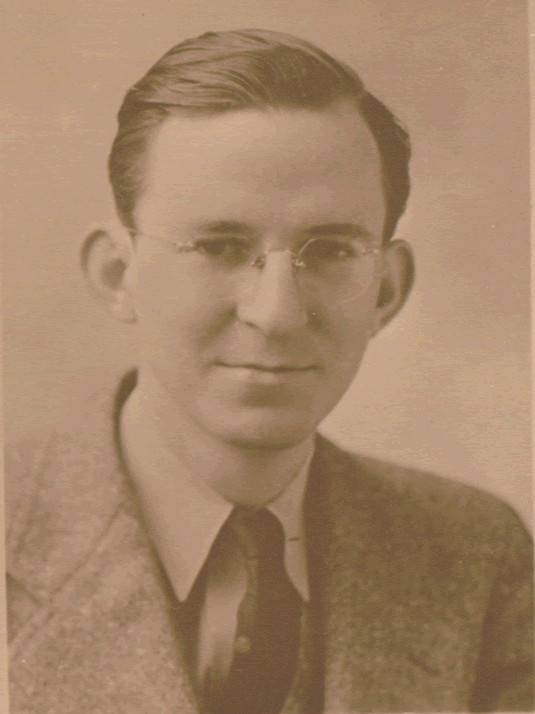
William R. Hollingsworth Jr. (1910-1944)1940s photograph. Courtesy of the Mississippi Department of Archives and History -
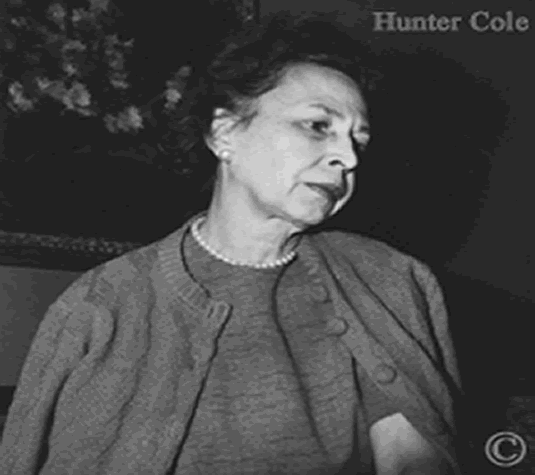
Jane Oakley Hollingsworth (1966) © Hunter Cole
-
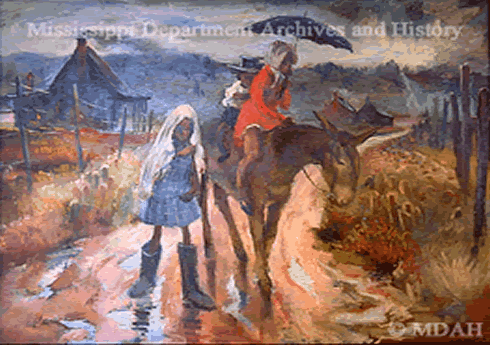
Brown and Wet (oil,1942) Kids on mule . . . my stuff, Hollingsworth wrote in his diary, confirming his insight into his affinity for Mississippi subjects. A companion to this oil painting, titled The Rains, was purchased by the film actress Maureen OHara. Collection of the Old Capitol Museum, courtesy of the Mississippi Department of Archives and History -
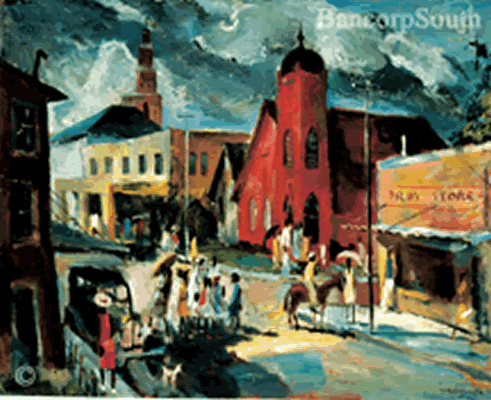
High Farish (oil, 1941) This study of a gathering outside the Baptist church on a cloudy Sunday captures the community spirit on Jackson's Farish Street in the 1940s. Courtesy BancorpSouth, Jackson -

Sudden Shower (watercolor, 1937) The antic charm of this watercolor recalls Hollingsworth's talent for drawing cartoons. The energy of the man and children dashing to shelter made Eudora Welty, who wrote about Hollingsworth's art, think of spinning pinwheels. Courtesy of the Mississippi Museum of Art, Jackson. Purchase 1937.003. -
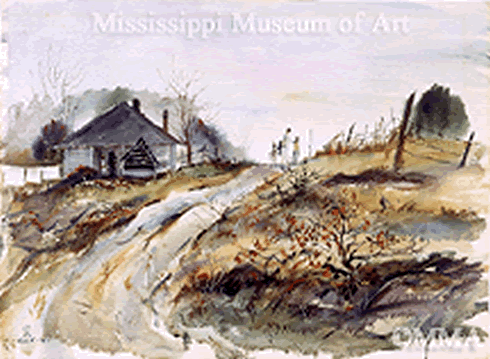
December (watercolor,1943) The scene of wistful, weary figures trudging home in the winter twilight accents the sad beauty that Hollingsworth's art reveals. Courtesy of the Mississippi Museum of Art, Jackson. Bequest of Jane Oakley Hollingsworth. 1987.045. -
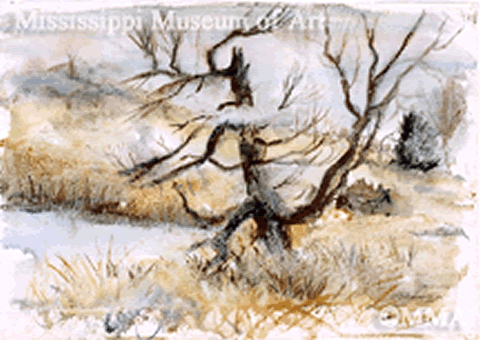
The Ice-Covered Tree (watercolor, 1943) Painted in below-freezing temperature, this muted winter scene achieves some of its mystery as the ice-crystals in the paint began thawing when the artist came indoors. Courtesy of the Mississippi Museum of Art, Jackson. Bequest of Jane Oakley Hollingsworth. 1987.034. -
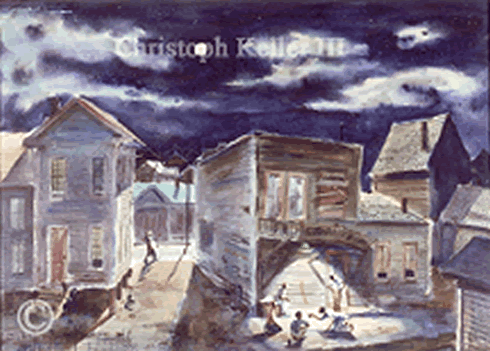
Ah, the Mystery of a Southern Night (watercolor, 1943) With a comic tone Hollingsworth creates a stage-set panorama to poke fun at late-night mischief and romance in the moonlit South. Courtesy of the Reverend Canon and Mrs. Christoph Keller III.
Suggested Reading
Harrison, Martha. “Hollingsworth’s Popular Medium Found Overnight.” Jackson Daily News, October 30, 1938.
Hollingsworth, Jane Oakley, and O. C. McDavid, editors. Hollingsworth: The Man, the Artist, and His Work. Jackson: University Press of Mississippi, 1981. Abridged and edited selections from Hollingsworth’s diaries, along with black and white sketches and full-color plates.
Hollingsworth Jr., William R. “Accepted Work Fails to Satisfy Painter in Spite of Praise.” Daily Clarion-Ledger, December 4, 1938.
Hollingsworth Jr., William R. “Monroe Sketch Club Exhibit To Be Shown Last Time on Sunday.” Daily Clarion-Ledger, April 13, 1940.
Hollingsworth Jr., William R. Miscellaneous cartoon illustrations. The Ole Miss. University of Mississippi, 1929.
Welty, Eudora. On William Hollingsworth. Jackson: University Press of Mississippi, 2002. Welty’s evaluation of Hollingsworth’s art, plus a chronology and a biographical essay.
